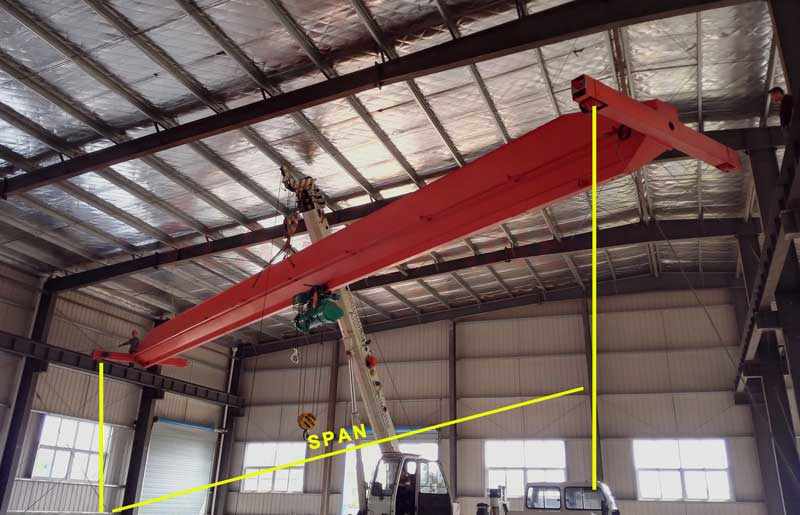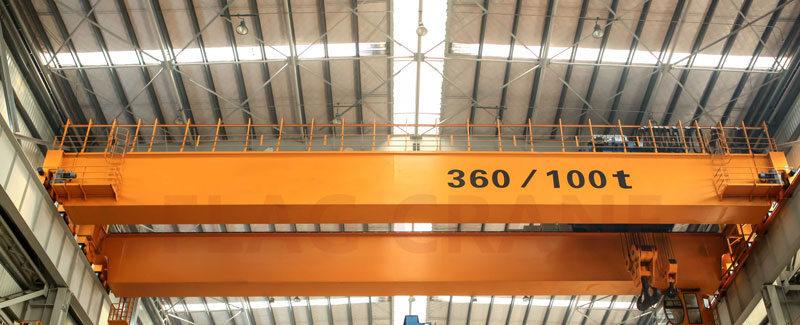0086-18695891045
Time : 2022-09-16
The parameters of bridge crane mainly are: lifting capacity, span, lifting height, travelling speed, lifting speed, working class, etc.
1.Mainly Parameters Of Bridge Crane-Lifting Capacity
The lifting capacity, also known as the rated lifting capacity, refers to the maximum load that the crane actually allows to be lifted, in tons (t). Overhead crane series lifting capacity such as 5, 10 (single hook), 15/3, 20/5, 30/5, 50/10, 75/20, 100/20, 125/20, 150/30, 200/30 , 250/30 (double hook) and so on. The numerator of the number is the main hook lifting weight, and the denominator is the auxiliary hook lifting weight.
Bridge cranes can be divided into three grades according to the lifting capacity, namely, 5~10t are small, 10~50t are medium, and more than 50t are heavy cranes.
2.Mainly Parameters Of Bridge Crane-Span
The distance between the center of the wheels at both ends of the main beam of the crane, that is, the distance between the center lines of the cart tracks is called the span, in meters (m). The spans of bridge cranes are 10.5, 13.5, 16.5, 19.5, 22.5, 25.5, 28.5, 31.5m, etc., and every 3m is a grade.
3.Mainly Parameters Of Bridge Crane-Lifting Height
The distance between the upper limit position and the lower limit position of the crane spreader or grasping device is called the lifting height of the crane, and the unit is usually "m". Commonly used lifting heights are 12, 16, 12/14, 12/18, 16/18, 19/21, 20/22, 21/23, 22/26, 24/26m and so on. The numerator is the lifting height of the main hook, and the denominator is the lifting height of the auxiliary hook.
4.Mainly Parameters Of Bridge Crane-Travelling Speed
The running speed of the running mechanism at the rated speed of the drag motor, the unit is "m/min". The running speed of the trolley is generally 40-60m/min, and the running speed of the cart is generally 100-135m/min.

5.Mainly Parameters Of Bridge Crane-Lifting Speed
The lifting motor of the hoisting mechanism picks up the rising speed at the rated speed, in m/min. Generally, the lifting speed does not exceed 30m/min, and the speed is determined according to the nature, weight and lifting requirements of the goods.
6.Mainly Parameters Of Bridge Crane-Power-on Duration Rate
Since the bridge crane works intermittently, its heavy work is expressed by the energization continuity rate JC%. The energization duration is the ratio of the working time to the cycle time, and a cycle is usually set as 10min. The standard energization continuity rate is specified as 15%, 25%, 40%, and 60%.
7.Mainly Parameters Of Bridge Crane-Working Class
Cranes can be divided into four types of work: light, medium, heavy and extra heavy according to their load rate and work busyness.

(1) Light grade: low working speed, less use times, less chance of full load, and 15% power-on duration. It is used in places that do not require tense and heavy work, such as cranes for installation and maintenance in hydropower stations and power plants.
(2) Intermediate: often work under different loads, medium speed, not too heavy work, 25% power-on duration, such as cranes used in general machining workshops and assembly workshops.
(3) Heavy-duty: heavy work, often working under heavy loads, with a power-on continuity rate of 40%, such as cranes used in metallurgical and foundry workshops.
(4) Extra-heavy level: The rated load is often lifted, the work is particularly busy, and the power-on duration rate is 60%, such as a bridge crane dedicated to metallurgy. Lifting capacity, operating speed and type of work are the three most important parameters of overhead cranes.
The above are the main parameters of bridge cranes, flagcrane can provide standard and non-standard bridge cranes, custom-designed and manufactured according to your actual working conditions and needs to meet your different needs.